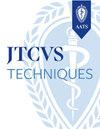Reoperative arch-first total arch repair after previous acute type A aortic dissection repair
IF 1.7
Q3 CARDIAC & CARDIOVASCULAR SYSTEMS
引用次数: 0
Abstract
Objective
We sought to review the outcomes of our arch-first total aortic arch repair (TAR) using a trifurcated graft after previous acute type A aortic dissection (ATAD) repair.
Methods
From February 2006 to June 2024, 62 patients underwent reoperative TAR after ATAD repair. The first-stage TAR includes axillary artery cannulation, minimal dissection without aortic crossclamping, myocardial protection using systemic potassium and retrograde blood cardioplegia, an arch-first technique with deep hypothermia (20 °C), and construction of a classical elephant trunk through a partial transverse incision distally or proximally to old distal aortic anastomosis.
Results
The median age at reoperative TAR was 63.5 years. The median interval from initial ATAD repair to reoperative TAR was 3 years. A concomitant procedure was performed in 20 patients (32.3%). The median cardiopulmonary bypass and lower body circulatory arrest times were 227.5 and 97 minutes, respectively. Operative mortality was 1.6% (n = 1/62), as was the incidence of stroke (1.6%) and renal-replacement therapy (3.2%). Stage II repair was performed or planned in 49 patients (open repair [above the celiac axis in most patients], n = 42; endovascular, n = 3; endovascular converted to open repair, n = 2; and waiting for repair, n = 2). Median interval between staged procedures was 63 days [interquartile range, 36, 134]. Mortality of stage II procedure was 4.3% (n = 2/47) with no spinal cord injury. Kaplan-Meier analysis showed that estimated survival at 5 years was 82.7 ± 6.7%.
Conclusions
Our reoperative TAR is safe in the setting of residual dissection that minimizes dissection of the cardiac structures, simplifies the distal anastomosis, and protects vital organs.
急性A型主动脉夹层修复术后再手术弓首全弓修复
目的:回顾急性a型主动脉夹层(ATAD)修复术后采用三分瓣主动脉瓣先行全主动脉弓修复(TAR)的结果。方法2006年2月至2024年6月,62例患者行ATAD修复后再手术。第一阶段TAR包括腋窝动脉插管,无主动脉交叉夹持的最小剥离,全身钾和逆行血液心脏截流保护心肌,深低温(20°C)弓优先技术,通过部分横向切口远端或近端到旧远端主动脉吻合处构建经典象鼻。结果再次手术的中位年龄为63.5岁。从首次ATAD修复到再次手术TAR的中位时间间隔为3年。20例患者(32.3%)接受了合并手术。中位体外循环时间为227.5分钟,下肢循环停止时间为97分钟。手术死亡率为1.6% (n = 1/62),卒中发生率为1.6%,肾脏替代治疗发生率为3.2%。49例患者进行或计划进行II期修复(开放式修复[大多数患者位于腹腔轴以上],n = 42;血管内,n = 3;血管内转开放式修复,n = 2;等待修复,n = 2)。分期手术之间的中位数间隔为63天[四分位数间距,36,134]。II期手术死亡率为4.3% (n = 2/47),无脊髓损伤。Kaplan-Meier分析显示5年生存率为82.7±6.7%。结论在残余剥离的情况下,再手术肝移植术是安全的,可以最大限度地减少对心脏结构的剥离,简化远端吻合,保护重要器官。
本文章由计算机程序翻译,如有差异,请以英文原文为准。
求助全文
约1分钟内获得全文
求助全文

 求助内容:
求助内容: 应助结果提醒方式:
应助结果提醒方式:


